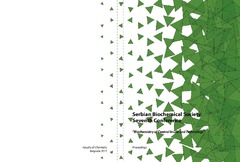Приказ основних података о документу
Semi - rational design of cellobiose dehydrogenase from Phanerochaete chrysosporium for increased oxidative stability and high-throughput screening of library mutants
| dc.creator | Balaž, Ana Marija | |
| dc.creator | Ostafe, Raluca | |
| dc.creator | Fischer, Rainer | |
| dc.creator | Prodanović, Radivoje | |
| dc.date.accessioned | 2019-12-19T14:38:38Z | |
| dc.date.available | 2019-12-19T14:38:38Z | |
| dc.date.issued | 2017 | |
| dc.identifier.uri | http://www.bds.org.rs/en/conferences.php | |
| dc.identifier.uri | https://cer.ihtm.bg.ac.rs/handle/123456789/3279 | |
| dc.description.abstract | Cellobiose dehydrogenase (CDH, EC 1.1.99.18) from Phanerochaete chrysosporium belongs to a group of oxidoreductases and has the ability to degrade different components of woody plants. CDH is secreted by wood degrading, phytopathogenic and saprotrophic fungi and this widespread appearance implies hers important function and makes her an important enzyme for applications in industrial and biotechnological processes, as well as biosensors and biofuel cells. CDH is also used in industry for bleaching cotton and in food industry for lactose detection. CDH is monomeric enzyme consisting of two domains, flavin domain containing FAD as cofactor and smaller hem b containing cytochrome domain, connected via flexible linker. Physiological role of CDH is reflected in the degradation of cellulose and lignin in cooperation with other cellulolytic enzymes, because CDH catalyzes oxidation of celobiose (Glc - β - 1,4 Glc) and other β - 1,4 - linked disaccharides and oligosaccharides to the corresponding lactons. Enzymes used in biosensors and for bleaching cotton should have high stability, especially toward reactive oxygen species. In order to improve oxidative stability of CDH, we have mutated CDH and tested its stability in presence of hydrogen peroxide. After successful cloning of the CDH gene in pYES2 vector, saturation mutagenesis was used to make library mutants where tree methionine residues were mutated. Residual activity of mutants was measured after the enzyme incubation in 0.3 M hydrogen peroxide for 0, 2 and 6h. After analysis of large number of mutants, it was observed that three mutants are showing higher oxidative stability compared to the wild - type enzyme. Residual activities of these mutants after 6 hour incubation in the hydrogen peroxide were over 50%, whereas wild-type has 30%. Selected mutants were expressed in S. cerevisiae and purified on DEAE column. Purity and activity of the enzymes were detected on the electrophoresis gel, oxidative stability of purified mutants was measured once again and characterization of these mutants was done. Mutants showing increased oxidative stability were sequenced and we have decided to combine these mutations with each other in order to make combined mutants that will be tested for oxidative stability. Screening library mutants for improved features in microtitatar plates is a long time process, in order to shorten the time necessary for screening libraries with 106 mutants we are developing fluorescent assay for flou cytometry. | en |
| dc.language.iso | en | sr |
| dc.publisher | Faculty of Chemistry, Serbian Biochemical Society | sr |
| dc.relation | info:eu-repo/grantAgreement/MESTD/Integrated and Interdisciplinary Research (IIR or III)/46010/RS// | sr |
| dc.rights | openAccess | sr |
| dc.rights.uri | https://creativecommons.org/licenses/by-nc-nd/4.0/ | |
| dc.source | Serbian Biochemical Society Seventh Conference "Biochemistry of Control in Life and Technology" - Proceedings | sr |
| dc.subject | Cellobiose dehydrogenase | sr |
| dc.subject | oxidoreductases | sr |
| dc.subject | electrophoresis | sr |
| dc.subject | mutants | sr |
| dc.title | Semi - rational design of cellobiose dehydrogenase from Phanerochaete chrysosporium for increased oxidative stability and high-throughput screening of library mutants | en |
| dc.type | conferenceObject | sr |
| dc.rights.license | BY-NC-ND | sr |
| dcterms.abstract | Остафе, Ралуца; Балаж, Aна Марија; Фисцхер, Раинер; Продановић, Радивоје; | |
| dc.identifier.rcub | https://hdl.handle.net/21.15107/rcub_cer_3279 | |
| dc.identifier.fulltext | https://cer.ihtm.bg.ac.rs/bitstream/id/15651/01_biochem2017.pdf | |
| dc.type.version | publishedVersion | sr |


